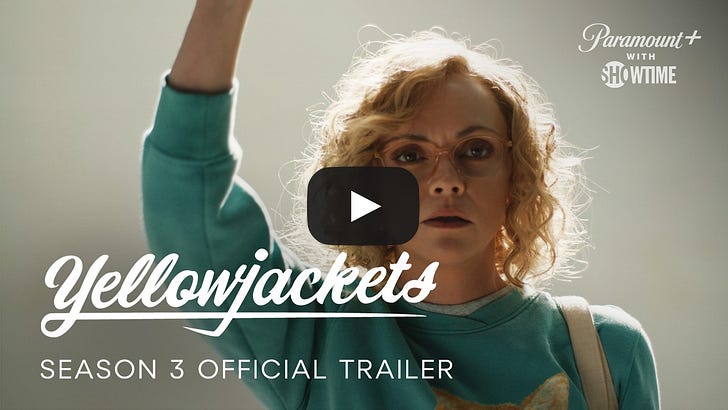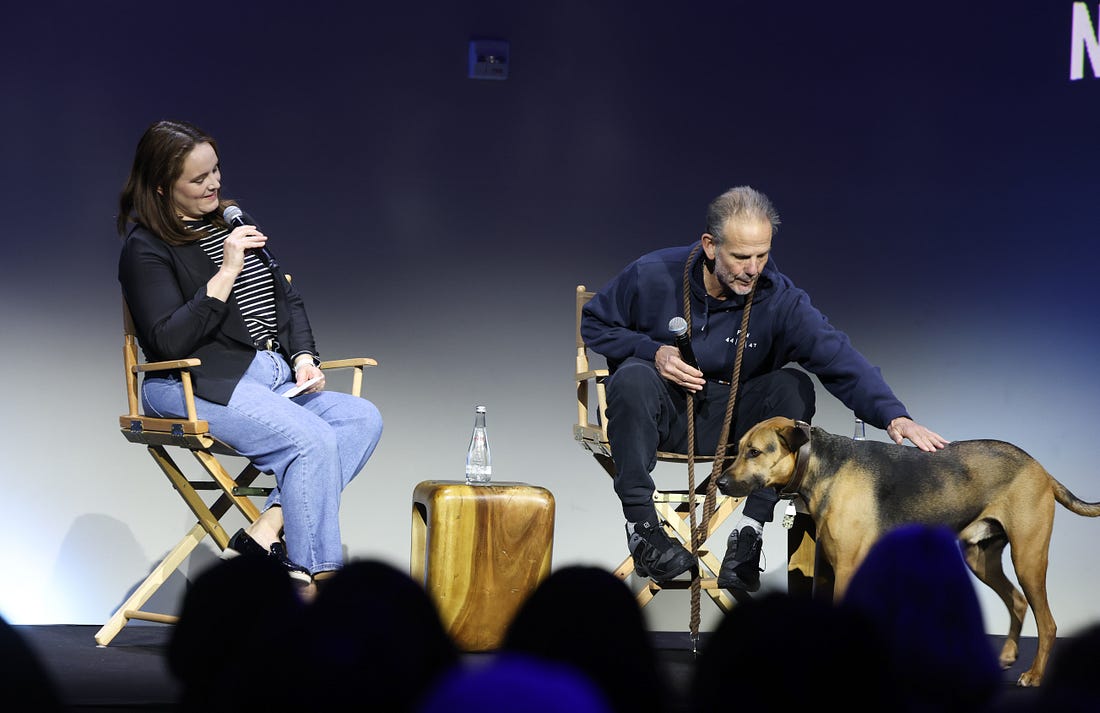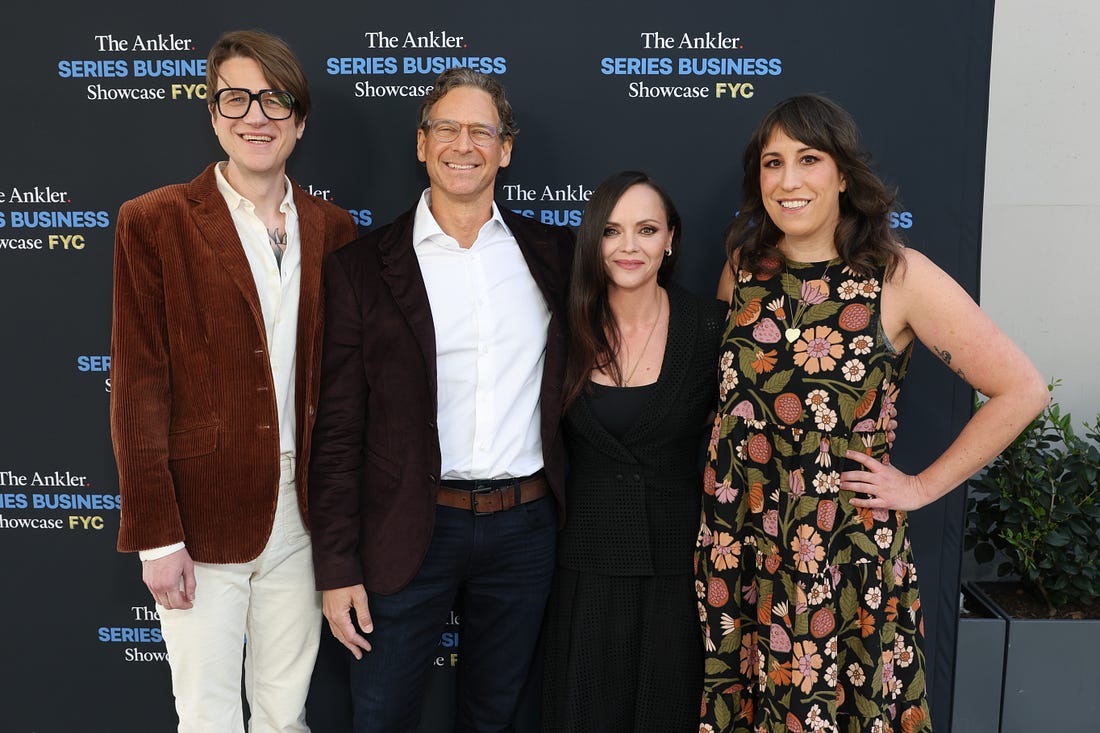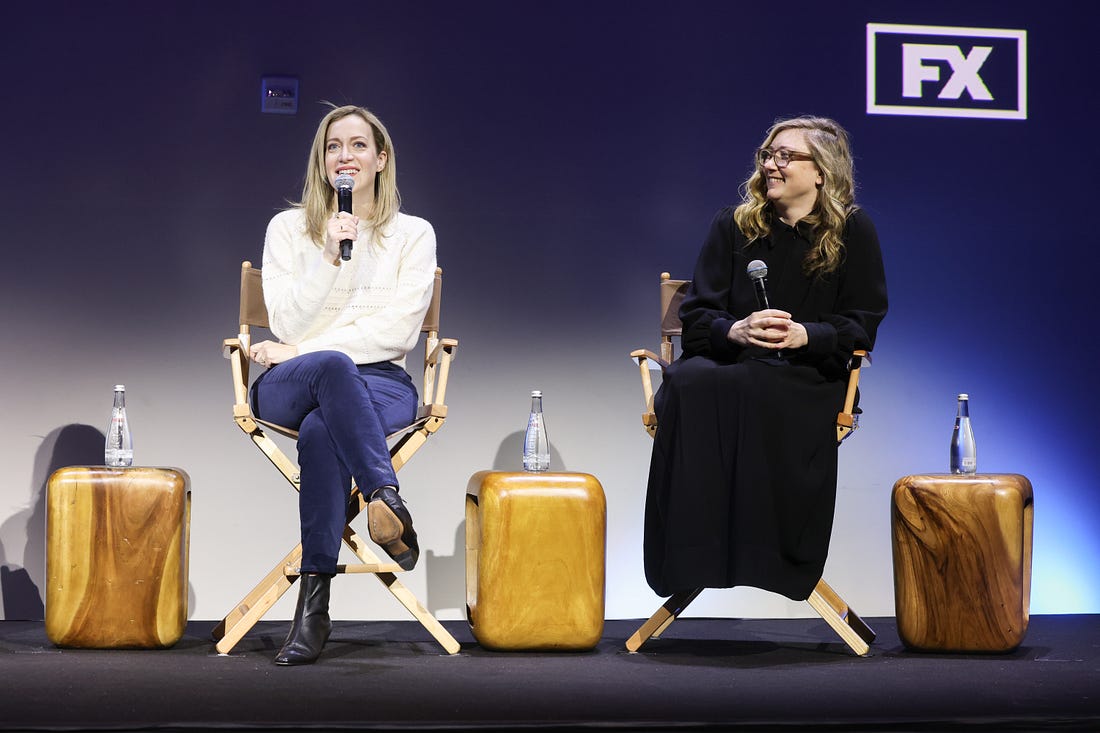→ You can now listen to all Ankler stories in the Substack app. Just hit the “play” arrow at the top right of the screen. Cannibal Queens to Cancer Sex: Creators on Risk & Ambition in the Algo AgeTeams behind 'Yellowjackets', 'American Primeval' and 'Dying for Sex' on the wild stories behind their buzzy shows — and what gives them hopeThere’s got to be an old Hollywood maxim somewhere that tells you never to let yourself be upstaged by a dog. But I challenge anyone to pull that off when sharing a stage with Eso, the beautiful golden-brown dog with soulful eyes who spends his days at the side of director Peter Berg. For our conversation about his Netflix limited series, American Primeval, kicking off The Ankler’s live Series Business FYC Showcase in early April, Berg was joined by Eso, as he was for the challenging 130 days of American Primeval’s New Mexico shoot. “That’s my co-director,” Berg said of Eso as they took the stage, with the audience audibly dazzled by Eso’s presence. “He was there every day, so he wanted to come and say hi to everybody.” Eso was a quiet, downright gentlemanly presence onstage, and I will admit that in the brief moment when he settled at my feet I felt genuinely starstruck. So maybe he upstaged me — worth it. My sit-down with Berg and Eso was the first of five captivating conversations with the players behind some of the year’s buzziest shows on stage at Neuehouse in Hollywood, a packed event sponsored by AMC, FX, Netflix, NBC and Paramount+. My colleague Elaine Low will share her experiences talking to the teams behind St. Denis Medical and Interview with the Vampire tomorrow (in a special bonus edition of Series Business), and today I’m looking back at what I learned about the making of American Primeval as well as Yellowjackets and Dying for Sex. Speaking in front of a room of industry professionals, the creators and stars behind these shows felt free to open up about how hard it can be to get a television show made these days, and sometimes even harder to stick to your guns and make the show as ambitious and daring as you want it to be. But when we asked all of them at the end of the panels what was making them feel optimistic about the industry, they shared some surprising insights about what makes all the crazy struggles worth it. I’m headed back to L.A. this week for some more Emmys FYC season events, and I’m looking forward to continuing to ask people what’s giving them hope these days. It’s not always easy to find, as I learned when talking to the team behind the scrappy indie The Legend of Ochi, but everyone seems eager to at least try to see the silver lining in an industry that can challenge even the best of talents. You can watch video of all five conversations here, and read the highlights from my three chats below. American Made The story of American Primeval begins with an axe. A real one — an antique ice axe, on display in Berg’s office, because as he explains it simply, “people give me weird things.” In a meeting with Mark L. Smith, who would become American Primeval’s creator, Berg handed Smith the axe and told him, “Can we do this as a show?” What he meant was a show that had the same spirit of adventure as well as sense of history and purpose. Berg directed all six episodes of American Primeval, which is both a rollicking Western and a slice of history, capturing the period in the 1850s when Utah was still a territory and hosting bitter battles between Mormon settlers, Shoshone and Paiute tribes and the United States government. Several real-life figures play key roles in the show, including Mormon leader Brigham Young and rugged settler Jim Bridger, captured by a scene-stealing Shea Whigham. (“We have like three jokes in the whole series, and those are all Shea Whigham,” admits Berg.) But at the heart of the narrative are two fictional characters — a woman fleeing a mysterious past back East, (Betty Gilpin) and the mountain man she teams up with (Taylor Kitsch). Berg and Kitsch go way back to Friday Night Lights (American Primeval shares a lot of DNA with the acclaimed high school football drama — Austin band Explosions in the Sky wrote the score for both shows), and Berg says the star is a strong collaborator who isn’t afraid to push back. “He’ll tell me if he doesn’t like something that I’m doing, if he thinks I’m doing a shortcut,” Berg says. “And I’ll do the same to him. I love that aspect of a relationship, and it’s unusual to get that in our business. You have people who pussyfoot around each other and take extra care not to upset or offend, and you end up swallowing some of your own truths.” Berg knows as well as anyone that the industry is in a weird place — he plays himself in an cameo on The Studio, the Apple TV+ series that takes it as a given that nothing in Hollywood is as satisfying as it ought to be. But after making the grim epic American Primeval a reality, he’s convinced that the passion it took to bring that show to the screen can work for the next generation of storytellers. “I tell people to dig in on ideas and visions that they feel really strongly about — stay with them,” says Berg. “Then take it to whoever you want to take it to, whether it’s a studio or Netflix or whatever, and let them feel your passion. And if they do, then you can get it made.” Buzz Buzz BuzzHow can you make your wildest ideas feel within reach? That’s the challenge for pretty much any series creator, and it felt particularly vivid for the team behind Yellowjackets this third season, who had so clearly established their wild world of cannibalism, mysticism, and ’90s nostalgia that they could go to some seriously dark places as the third season concluded. “We always knew that the consequences were going to start catching up with them in more ways than one,” says Ashley Lyle, who joined her fellow showrunners Bart Nickerson and Jonathan Lisco as well as star Christina Ricci onstage. Ricci plays the adult version of Misty, who survived years in the wilderness alongside the rest of her soccer team and is still haunted by the experience as an adult, especially when spending time with frenemies like Shauna (Melanie Lynskey) and Tai (Tawny Cypress). There was a time when Misty, an amateur detective with a pet parrot named Caligula, seemed like the kookiest of the adult Yellowjackets. But by the end of this season, that idea had certainly dissipated, particularly after one gruesome scene where Shauna takes a bite out of the arm of a fellow survivor (played by Hilary Swank) — and then forces her to eat it. “It’s really important that we lay pipe for all of these things, so that it feels earned for the audience when we get there,” says Lisco. “Sometimes people will say ‘Well, this aspect was a slow burn,’ but I submit that it needs to be a bit of a slow burn so that when Shauna says eat your arm, it’s not just a shocking moment. It makes sense on a psychological level.”  For Ricci, the season was building up to a point where Misty could break free of the so-called friends who had been demeaning her since childhood. “It’s a matter of the audience having gone through this with her,” the star says. “It’s really gratifying when she says, ‘These are not my friends. Fuck this.’” Misty still hasn’t let go of her sleuthing skills, though, and this season finds a major revelation in her latest case while drinking, of all things, a chocolate martini. Ricci said the script called for a Brandy Alexander, but a chocolate martini felt more like Misty — and the showrunners welcomed the switch. “The story is ever unfolding, and the particulars do shift around,” says Nickerson of moments like this, where the actors share insight into their characters that even the creators might not know. “The more deft and nimble an actor’s process, the more room it leaves you, because they need less of the particulars.” Sex, Death & Everything in BetweenIn the middle of Covid lockdowns, Liz Meriwether reached out to her longtime friend Kim Rosenstock with a truly unexpected and somewhat unwelcome suggestion. “I was like, ‘Are you really going to make me listen to a podcast about dying of cancer?’” Rosenstock says of the first moment she heard about the non-fiction podcast Dying for Sex. “And then she was like, ‘Well it’s also about sex,’ and I was like, ‘Well, I’m only human. Yes, send me the link.’” That combination of instinctive human drives — seeking sex and confronting death — generates unlikely magic on Dying for Sex, the FX limited series co-created by Meriwether and Rosenstock, who previously worked together on the sitcom Meriwether created, New Girl. A show about longtime friendship — Michelle Williams and Jenny Slate star as friends whose relationship deepens dramatically when Williams’ character receives a terminal diagnosis — Dying for Sex felt in some ways destined, even though it took a long five years to come to life. “There was just something about this show that I knew deep down it was going to happen at some point,” says Meriwether, who made the Hulu limited series The Dropout while Dying for Sex endured multiple delays. During that time, she adds, “It was nice to have a second to think. For New Girl, we both spent six or seven years on network television having no time to write stuff the night before. It’s a really different world now with streaming.”  Despite its heavy material, Meriwether describes Dying for Sex as being built from “sitcom muscle memory,” including its half-hour episodes, an incredibly rare choice for a limited series. “I don’t know why they greenlit it,” jokes Meriwether. “Nobody is making any money on this.” Rosenstock adds, though, that the episodes expand along with the characters as the show goes on. “The whole world seems like it’s growing in the show,” she says. “It was cool that FX was allowing us to be a little bit looser with the time.” Rosenstock and Meriwether took a class through the WGA specifically about writing sex scenes, which both found far more informative than they ever expected. “I wrote a movie in 2011, which was the last time I had written sex scenes,” says Meriwether, referring to her early career rom-com No Strings Attached. The WGA class “basically just said, ‘Be as specific and clear as you can, and use clinical words,’” she adds. “It told people that your job as a writer is to tell people exactly what’s in your head, and don’t shy away from that.” There’s a wide range of sex scenes on Dying for Sex, but all of them share a kernel of authenticity, as well as Rosenstock and Meriwether’s firmly held belief that a sex scene doesn’t have to be just one thing. “I don’t know the kinds of sex everyone’s having, but you can be laughing about something while having sex, and then it can turn on a dime and be very hot,” says Rosenstock. “It was kind of fun to say we’re not choosing one or the other. We’re not choosing steamy vs. comedy.” Follow us: Instagram | YouTube | LinkedIn | Bluesky | TikTok | X | Threads | Facebook | WhatsApp ICYMI
Like & Subscribe, a creator economy newsletterThe Optionist, a newsletter about IP |





